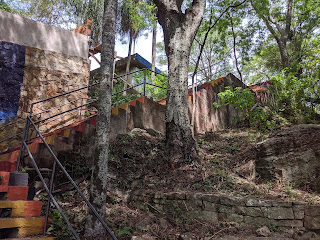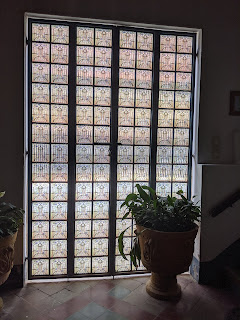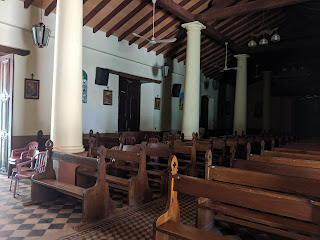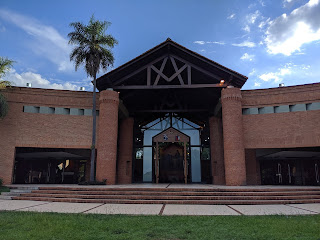Jose, our driver and guide we'd hired for a week, picked us bright and early from our accommodation in the Golden Circle town of Aregua so we could hike two minutes away at the Monumento Natural Cerra Koi. It was named for the Koi and Chorori cerros or hills famed for an interesting geological formation that was almost unique.
Surprisingly, because Paraguay wasn't really set up for tourists in our admittedly brief experience so far, there was a very informative pamphlet in English that described the highlights along the Ita Puku Trail through most of the monument. Ita or 'rock' and puku or 'long' were the Guarani words given to the path so we could appreciate the peculiar rock formation.
Jose mentioned the tree to his left with a peculiar bark with many protuberances or bumps was called a kurupa'y renda. The tree is often used for construction and firewood.
Though we were so close to the urban area of Aregua, the park was home to many animals like armadillos, mountain foxes, grey deer and a large variety of birds. With its large rocks, the trail wasn't quite as smooth as we were used to back home but it was so enjoyable getting out of the car for a bit!
Before being a protected area, many people came to this place who believed in plata yvyguy or hidden treasure. It was a common belief in Paraguay that became more popular after the Triple Alliance War.
At this part of the trail were examples of amba'y, a plant used as a natural medicine for respiratory ailments. Interestingly, it was also one of the first specimens in repopulating deforested areas as it's known as 'the hole where trees grow.'
Jose wanted to stop for a few minutes at the Los Alpes Hotel that had been founded by the first German immigrants so we could watch a dancing couple coming out of the cuckoo clock in front of the hotel!
Altyra was famous in Paraguay for having won the title of Fourth Cleanest Town in the World years ago after promoting trash shouldn't be thrown away in the streets! This was the first town we'd been to in Paraguay that had such attractive sidewalks, something we're so accustomed to in North America, but we knew not to take for granted in Paraguay.
The little statue of the Virgin was what everyone had come to see.
Jose mentioned the tree to his left with a peculiar bark with many protuberances or bumps was called a kurupa'y renda. The tree is often used for construction and firewood.
This area was known as Kava Ita or 'the wasp rock' because, after walking in a few meters, there was a beautiful wall of rocks that resembled a wasp's honeycomb. Coincidentally, in the upper part, it was common to find red-colored wasps! It reminded us of the interlocking basalt columns we'd seen just a couple of months ago at Giant's' Causeway on the north coast of Northern Ireland.
We read that something similar, but not the same, has been found in Canada, South Africa and more recently in Egypt.
A Pindo palm tree:
At the 6th stop on the walk, we had the best view of the formation of columnar sandstones. They had been quarried until 1993 when conservation became more important and the area became a national monument. What was so unusual is that you normally see basalt rocks in this shape, but not sandstones. Isn't nature phenomenal?!
I probably shouldn't have but I did take one of the small rocks that had fallen on the ground as they were so fascinating!
From a viewpoint on the trail, we had a marvelous view of the idyllic-looking Lago Ypacarai. Jose mentioned that the lake had been heavily polluted by industry and residents. Both Spain and Taiwan had made valiant attempts to clean the lake but there had been no subsequent education directed to the people who had polluted it in the first place.
We were glad to end the hike at 9 when it was already 80 degrees! As we drove, Jose chatted about why Paraguay had a significant German population. The President received a letter in 1881 from people in Germany indicating they wanted to move to Paraguay. He promised oxen equivalent to a tractor, free transportation from the docks at Buenos Aires, Argentina, and ten acres of land they wanted anywhere in the country. The Germans arrived only to find that the president had been overthrown so the new president, Bernardino Caballero, was approached to see if the original offer could be approved. It was! The German immigrants subsequently founded the town of San Bernardino, which they named after the second president who had assisted them. They also started the country's first brewery.
It seemed so weird seeing this sign advertising the distances to Honolulu and Waikiki in Hawaii! Jose explained that the Rodara gas company was offering a trip there as a grand prize.
This area was pretty affluent as beyond the private lake was a mansion, according to Jose. Jose mentioned that the infamous Nazi doctor Josef Mengele had lived nearby when he had sought refuge in Paraguay after WW II.
Jose wanted to stop for a few minutes at the Los Alpes Hotel that had been founded by the first German immigrants so we could watch a dancing couple coming out of the cuckoo clock in front of the hotel!
I can't remember when was the last time I laughed so hard when Steven decided to dance around me as I was taking a video of the dancing couple! Lina: So glad your grandchildren also got a hoot out of the video I sent you that day!
Jose wanted to show us what looked like a Greek amphitheater outside of San Bernardino that we hadn't known about beforehand. Situated high on a hill, it had commanding views of the lake. Unfortunately, though, like so much else in Paraguay, the open-air Anfiteatro Jose Asuncion Flores named after the country's famous musician, had seen better days and there was no money to repair what would have been a lovely concert venue.
The town of San Bernardino, or San Ber for short, was the number one beach resort for Paraguayans because of its proximity to the capital of Asuncion and also because the lake was immortalized in a song. The town had developed into a fashionable place among Paraguayan towns and a good number of Asuncion residents had weekend retreats there, even though the lake was polluted and swimming wasn't recommended!
It was quite fascinating when Jose shared with us that people from abroad see opportunity and have a vision as to what can be done to improve Paraguay, whereas its citizens see the problems. It was definitely a perspective of a glass half-full versus a glass half-empty unlike I had heard before in this type of situation. Jose seemed hopeful about the young people studying abroad who then return to Paraguay and may be the elements of positive change.
San Ber was a great place to live because of its great weather year-round. It has therefore become a favorite destination for Europeans, many of whom have bought up homes in the town. One of the busiest months is January. Jose laughed when he said that, "You're no one if you're not seen in San Ber that month!"
The town was so pretty and gracious with its picture perfect avenues lined with palm trees. If we had been there in late October, there would have been a German Oktoberfest, complete with beer, cakes and German folk dancing!
The lovely road in the photo above led gently uphill to the sweet Virgen del Mirador church. Only people who are born in San Ber could celebrate marriages and other life events there - there was another church for visitors and newcomers not far away!
It was so peaceful and welcoming, I would have loved to attend a Mass there.
Its grounds were immaculately maintained and had a very colorful grotto and Stations of the Cross.
I don't know whether Jose wanted a break or whether it was just out of the goodness of his heart that he recommended Steven and I hike up gobs of steps to the Mirador Bella Vista or Pretty View Lookout!
On the first landing was this outline of a Paraguayan bird. It was a great chance to rest as we had a long way to go to reach the top!
This mural of an indigenous person was about half-way up as I recall.
In the plaza at the top of the 100 steps was a tall modern white statue of the Virgin that had been constructed in 2018.
On the other side of Lago Ypacarai was Cerro Koi, the hill we'd climbed that morning.
We walked down to the lake where the water level was terribly low. If we had more time that day, it probably would have been fun to while away some time on a pedal-boat or a big flat-bottom boat ride but we still had lots of places to go!
Right by the lake were lots of craft stalls selling nanduti lace products, attractive leather items, etc unique to Paraguay. I felt badly for the vendors as we were the only ones around, Janina, in case you were wondering again!
The Hotel del Lago or Lake Hotel in sleepy San Ber was, as Jose described it, a big hotel far away from anywhere but where big-name stars had come to get away from everything.
Greta Garbo, Marlene Dietrich, Joan Crawford and other stars stayed at the hotel.
Lina Krauss and Pedro Herken were the owners of the first beer company in Paraguay at the beginning of the 20th century.
This gallery had been dedicated to Cira Moscarda, a talented Paraguayan artist and teacher who was against Stroessner's dictatorship and was described as liking "innovative experiences, and a lover of peace."
Lina: This was where I called you from for your birthday. I remember you were busy with Erica that day. As we sat down to enjoy a lovely lunch, or, in my case, some yummy homemade ice cream, we had to be careful and not get beaned by the falling mangoes!
The chef put out bananas to attract monkeys but none made an appearance unfortunately while we were there. The flowers, though, were gorgeous.
Wilhelm Weiler was an entrepreneur who envisioned San Bernardino as a vacation resort and founded the Hotel del Lago after arriving from Germany in 1888. In a few years, he converted the village into an exclusive enclave, built two hotels and restaurants, a port with steamboats and a Hippodrome.
This was the first in a long time to add to my collection of bathroom signs!
The hotel was far grander than our very humble abode in Aregua!
Its Tigress Suite was where the longtime Swedish girlfriend of French writer and aristocrat, Antoine Saint-Exupery, stayed. Most well known as the author of The Little Prince, Saint-Exupery was also an aviator who delivered mail all over South America.
In the plaza across from the hotel was a magnificent, very old tree that spread its branches in the middle and was called Arbol de la Vida or Tree of Life.
I bet the plaza would have been charming at night with its Chinese-looking lanterns lit.
I wasn't trying to take pictures with no one else in them. There just wasn't anyone else around!
Only the Casa Hassler had seen better days in scenic San Ber!
It was strange walking around the town, seeing the German signs and street names everywhere. I questioned Jose why there were so many English words on signs unlike anywhere else in Paraguay. He replied it was because the people had a fascination with US culture, and to be modern, locals liked using English words to be fashionable!
This building had been built around a tree!
We peeked at the vacation home of former President Alfredo Stroessner that had been taken from him after the dictator was overthrown in 1989 after being in power for 35 years, the longest of any ruler in South America.
The town's war memorial was next to the tiny and pretty church of the Virgen del Fatima. That was the one where non-locals could marry! Unlike the churches in the capital, those in San Ber were open to visitors.
In addition to his many other talents, Jose was an avid bird watcher. I forgot, though, to write down what this bird was!
From San Ber, we climbed the hills to the town of Altos, which was the very first Franciscan Reduction and the model for the later Reductions, including the Jesuit Reductions. As I wrote in an earlier post, both the Franciscan and Jesuit clergy who had come to Paraguay in the late 16th century, had adopted a strategy of gathering the indigenous people into communities called "Indian Reductions." Their objectives were to organize and exploit the indigenous inhabitants while also imparting Christianity and European culture.
The Church of San Lorenzo de Altos dated from the end of the 19th century and was part of the Marian Camino or Way.
Like the churches we'd seen the previous day in Luque and Capiata, this, too, had a stunning traditional colonnade on each side of the church.
The sculpture in the main plaza was dedicated to Luis Alberto del Parana, the most famous Paraguayan singer and who also promoted Latin American music.
Surrounding the plaza were the first of the 'casas de indios' that were so common in southern Paraguay. The casas were rows of single-story buildings where the relocated Indians were moved by the clergy and that always bordered the church.
It was so enchanting seeing another immaculate park and church after the disappointing ones in the capital.
On Good Friday, the crucifixion of Christ is commemorated here from noon to sunset in an outdoor Calvary constructed beside the church with parishioners dressed as the apostles and three carved figures on the crosses.
As Altos was the first of all the German towns in Paraguay, it wasn't too strange to see opposite the park the German Community House.
We asked Jose to stop on the way to Altyra as we had spotted what looked like a very unusual town cemetery from the road. Steven and I wandered around it for a brief while as we noticed there didn't appear to be any names or dates listed on any of the graves. If you've been a longtime reader of this blog, you may recall we have stopped in many a cemetery on our travels, yet this was the first to have no names!
I hope I don't sound too irreverent when I say that many of the graves looked more like colorful doghouses or doll houses!
I'm sure Jose thought us 'weird' when we kept going on about what an unusual cemetery it was from our viewpoint.
Altyra was translated, according to Jose, as a 'place to meet' which meant a sacred place where the indigenous people met at the beginning of the European conquest of Paraguay to find solutions to problems.
The town was now famous for its leather artisans. I bought a couple of tooled leather belts that only cost $5 each, even after more holes were punched in them! Once again, we were the only people around.
The town's church was closed, not that we minded that much as we'd sort of had our fill of churches for the day!
As it was nearing Christmas, there were Christmas trees along the highway.
Tobati was the next town we hit on the Golden Circuit and the furthest east. Known for its woodcarving and pottery, the Guarani name meant 'white clay.' Bricks for the Presidential Palace in Asuncion came from Tobati as the town had had brick factories since colonial times. One of the oldest towns in the country, Tobati had been founded in 1539 as a village for the indigenous by Domingo Martinez de Irala. A politician, he consolidated the Spanish conquest and is sometimes considered as the father of Paraguay. In 1583, a Franciscan turned it into one of the first Christian missions.
After passing several brick factories, we saw some low hills with distinctive rock formations on their cliff faces, as the stone had weathered to form interesting shapes.
At the foot of one of the cliffs was the Virgen del Paso or the Virgin of the Way. Sadly, someone had recently died falling off the cliff.
We stopped to climb to the top of the monument of the Tres Caras de Indios or Three Heads of Indians. Everywhere we looked were brick factories!
How's your Spanish? Did you understand the colorful sign that meant Tobati was the town of love?!
You've probably figured by now I was more than a tad intrigued seeing all the Paraguayan crafts so stopping at the Villa Artesanal was my cup of tea! It had a huge range of high quality crafts but most were far too big for us to lug home.
Cute and great-priced girls' dresses for sale caught my attention.
If this piece hadn't been ungodly heavy, I would have bought this in a heartbeat as a wonderful memory of our time in Paraguay.
In the middle of the town plaza was the town church that almost looked like a chateau with its twin turrets.
Tobati was also the home of Zenon Paez, the most famous sculptor of wooden saints in Paraguay. Born into a family of santeros or saint-makers, his children has carried on the family tradition just as the Rodriguez children did in Capiata.
Paez had received Paraguay's highest civilian honor for his achievements.
Then it was onto the next town on the Golden Circuit, Caacupe, Paraguay's spiritual capital. If we'd been there just two days earlier for the feast day of the Immaculate Conception, we would have been amid one million pilgrims from all over Paraguay who had made a prayer bargain with the Virgin. The bargain went along these lines: If 'such and such' happens in my favor, I promise to make the pilgrimage to Caacupe on December 8th.
Holy water bottles in the shape of the Virgen del Caacupe were available for the faithful.
We read that some walk all the way from the capital, some arrive on bikes, some make their way on their knees 18 kms from Ypacarai, while still others walk 29 kms from another town carrying enormous crosses. The well of water was considered to have healing properties.
The smaller church by the shrine was the old basilica.
In the plaza by the smaller church were a gazillion, dare I say it, tacky plaster figures for sale!
The basilica was far grander and larger than the cathedral in Asuncion and had been blessed by Pope John Paul II when he visited in May of 1988. I could easily imagine a million or so people crowding into the square in front of the basilica.
I watched with great admiration as a few women made their way to the altar on their knees.
At the top of the basilica was a series of murals that depicted the history of the Virgin of Caacupe.
The little statue of the Virgin was what everyone had come to see.
Jose wanted to show us the small town of Pirayu next as it was important because General Jose Diaz, the hero of the Triple Alliance War who beat Argentina in one of its most decisive battles, had been born there. The town with colonial buildings from the 1800s looked absolutely moribund as there wasn't a soul around. It looked like a place where time had stood still!
The former train station had a lone locomotive in the rear.
The more attractive front of the former station:
By the station were ovens where chipas, one of Paraguay's national foods, is made. Like a cheese bread, it's especially popular at Christmas Eve dinner where Jose laughingly told us Paraguayans like to eat and drink like there's no tomorrow! Typically, a family of four cooks as if they were a family of twelve! Wine, whiskey, sweet cider are all mixed together in a drink called clerico and only drunk then. Gag me, please, was all I could think of that concoction!
Being able to see Pirayu had been an unexpected bonus as it hadn't been on our itinerary and we'd known nothing about it.
Many roadside stands sold strawberry liquor as well as liquor made with passion fruit and other local fruits.
The last town on the Golden Circuit was Ypacarai that, strangely enough, wasn't actually on the lake of the same name that we'd seen earlier that day but was south of it. The town, which literally means "Water, sir?" was one of the points of departure used by pilgrims walking to Caacupe each December 8. Near the town was Tuparenda, the retreat house of the Marian Schoenstatt movement that began in Germany.
The bishop of Caacupe was the founder of this Paraguayan branch. Meaning God's Place in Guarani, Tuparenda was a very large compound that we were free to wander around. Nearing the central church, we could hear some of the most uplifting music I can ever remember. I so wished I could have bought a CD as it made a huge impact on me.
The Stations of the Cross:
I had never before had any desire to attend a religious retreat but I found Tuparenda an awe-inspiring place even with only one or two people around. I could almost 'feel' the sense of peace and serenity of the Catholic faithful as we strolled the grounds of the Schoenstatt property.
The three of us enjoyed pizza and drinks for just $10 that night back in Aregua after another 12-hour day and driving 150 kms. You can be sure we collapsed into bed at 10 when Jose dropped us off at our hotel!
Next post: More spectacular nanduti lace, and churches en route to southern Paraguay.
Posted on February 11th, 2020, after a tumultuous day trying to come up with places to go for three weeks instead of China in the middle of our upcoming trip to Asia that begins on March 1st!















































































































































































Your blogs introduce me to such unique and beautiful corners of our amazing world.... the extraordinary red rock structures on the Ita Puku Trail, the fascinating history (complete with celebrity-frequented hotel) and heritage of San Ber and of course the beautiful churches that populate Paraguay. And thrilled to see the place from which you called me for my birthday.. thank you dear friend for never forgetting "my" day no matter where you are ! xo
ReplyDeleteLina,
DeleteParaguay could so easily have been we overlooked in our quest to get off the beaten track and explore the unusual. What a treat it was to explore so much of the wonderful country once we escaped from the capital city of Asuncion. I would urge anyone to travel to Paraguay based on our experiences as the country was a fascinating mix of history, cultural sights and very attractive natural beauty.
Wonder where we'll be on your birthday this year, dear friend! I'll be sure to call from wherever that may be.
XOXO
Boy, you accomplish a lot in a day!!! Janina
ReplyDeleteAmazing what you can see when you have a driver!
DeleteReally, Janina, you think!! Fortunately, it didn't seem too much then and there!
Delete